What Do Photographic Process Worker or Processing Machine Operator Do?
Photographic Process Worker or Processing Machine Operator Job Description Perform work involved in developing and processing photographic images from film or digital media. May perform precision tasks such as editing photographic negatives and prints.
Daily Life Of a Photographic Process Worker or Processing Machine Operator
- Measure and mix chemicals to prepare solutions for processing, according to formulas.
- Operate special equipment to perform tasks such as transferring film to videotape or producing photographic enlargements.
- Upload digital images onto Web sites for customers.
- Review computer-processed digital images for quality.
- Operate machines to prepare circuit boards and to expose, develop, etch, fix, wash, dry, or print film or plates.
- Load digital images onto computers directly from cameras or from storage devices, such as flash memory cards or universal serial bus (USB) devices.
Featured schools near , edit
What Skills Do You Need to Work as a Photographic Process Worker or Processing Machine Operator?
Below is a list of the skills most Photographic Process Workers and Processing Machine Operators say are important on the job.
Operation Monitoring: Watching gauges, dials, or other indicators to make sure a machine is working properly.
Active Listening: Giving full attention to what other people are saying, taking time to understand the points being made, asking questions as appropriate, and not interrupting at inappropriate times.
Quality Control Analysis: Conducting tests and inspections of products, services, or processes to evaluate quality or performance.
Reading Comprehension: Understanding written sentences and paragraphs in work related documents.
Speaking: Talking to others to convey information effectively.
Service Orientation: Actively looking for ways to help people.
Types of Photographic Process Worker or Processing Machine Operator
- Photographic Spotter
- Color Laboratory Technician
- Drum Operator
- Quality Control Head
- Film Processing Utility Worker
Photographic Process Worker or Processing Machine Operator Employment Estimates
There were about 26,900 jobs for Photographic Process Worker or Processing Machine Operator in 2016 (in the United States). There is little to no growth in job opportunities for Photographic Process Worker or Processing Machine Operator. Due to new job openings and attrition, there will be an average of 3,300 job openings in this field each year.
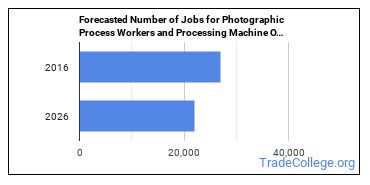
The states with the most job growth for Photographic Process Worker or Processing Machine Operator are Maryland, Nevada, and Georgia. Watch out if you plan on working in Wyoming, Hawaii, or Delaware. These states have the worst job growth for this type of profession.
Salary for a Photographic Process Worker or Processing Machine Operator
The salary for Photographic Process Workers and Processing Machine Operators ranges between about $21,050 and $53,200 a year.
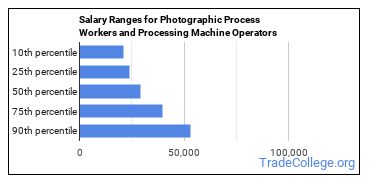
Photographic Process Workers and Processing Machine Operators who work in New York, Maryland, or California, make the highest salaries.
How much do Photographic Process Workers and Processing Machine Operators make in different U.S. states?
| State | Annual Mean Salary |
|---|---|
| Arizona | $35,820 |
| California | $47,360 |
| Colorado | $37,170 |
| Connecticut | $33,410 |
| Delaware | $33,410 |
| Florida | $32,930 |
| Georgia | $26,750 |
| Hawaii | $32,000 |
| Idaho | $44,880 |
| Illinois | $37,700 |
| Indiana | $24,770 |
| Iowa | $29,150 |
| Kansas | $33,660 |
| Kentucky | $26,780 |
| Louisiana | $44,280 |
| Maryland | $35,740 |
| Massachusetts | $33,980 |
| Michigan | $31,340 |
| Minnesota | $35,540 |
| Missouri | $34,720 |
| Nebraska | $32,200 |
| Nevada | $31,500 |
| New Hampshire | $32,470 |
| New Jersey | $33,790 |
| New Mexico | $29,600 |
| New York | $45,300 |
| North Carolina | $31,350 |
| North Dakota | $31,290 |
| Ohio | $32,200 |
| Oklahoma | $27,590 |
| Oregon | $39,570 |
| Pennsylvania | $25,920 |
| South Carolina | $28,970 |
| South Dakota | $30,780 |
| Tennessee | $25,820 |
| Texas | $30,420 |
| Utah | $31,440 |
| Virginia | $27,820 |
| Washington | $35,690 |
| West Virginia | $31,330 |
| Wisconsin | $30,180 |
What Tools & Technology do Photographic Process Workers and Processing Machine Operators Use?
Below is a list of the types of tools and technologies that Photographic Process Workers and Processing Machine Operators may use on a daily basis:
- Microsoft Excel
- Microsoft Word
- Microsoft Office
- Microsoft PowerPoint
- Microsoft Access
- MySQL
- MongoDB
- Adobe Systems Adobe Photoshop
- Microsoft Publisher
- Adobe Systems Adobe InDesign
How do I Become a Photographic Process Worker or Processing Machine Operator?
Individuals working as a Photographic Process Worker or Processing Machine Operator have obtained the following education levels:
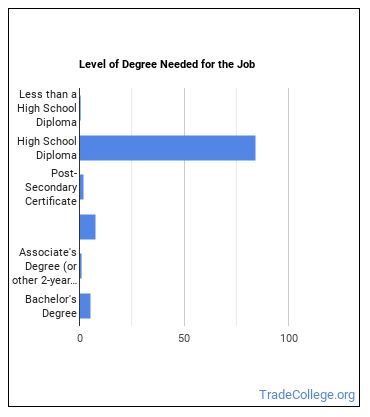
How many years of work experience do I need?

Who Employs Photographic Process Workers and Processing Machine Operators?
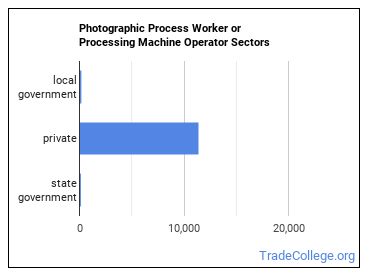
Photographic Process Workers and Processing Machine Operators work in the following industries:
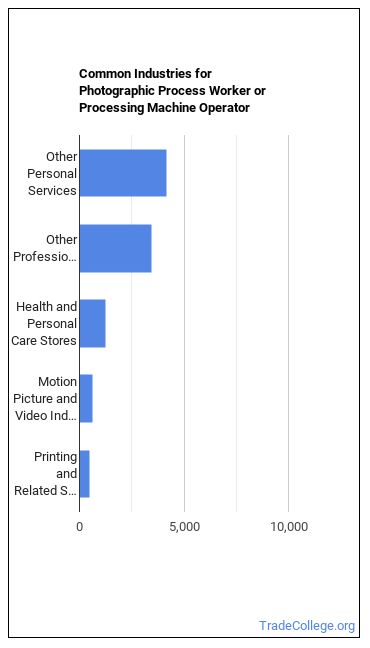
Other Jobs You May be Interested In
Those interested in being a Photographic Process Worker or Processing Machine Operator may also be interested in:
Career changers with experience as a Photographic Process Worker or Processing Machine Operator sometimes find work in one of the following fields:
References:
More about our data sources and methodologies.
Featured Schools
 Request Info
Request Info
|
Southern New Hampshire University You have goals. Southern New Hampshire University can help you get there. Whether you need a bachelor's degree to get into a career or want a master's degree to move up in your current career, SNHU has an online program for you. Find your degree from over 200 online programs. Learn More > |
